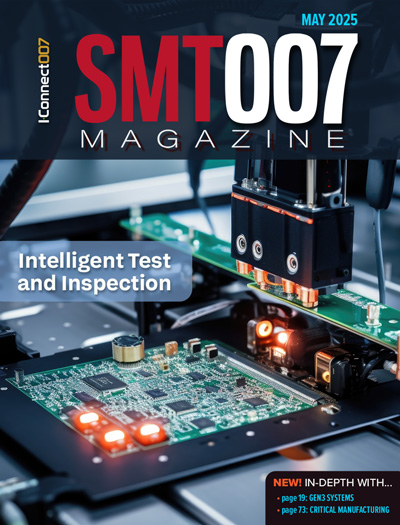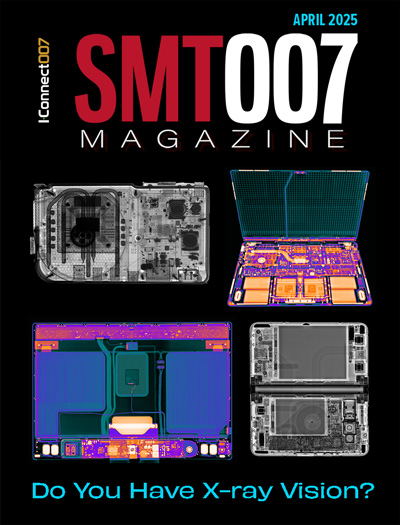-

- News
- Books
Featured Books
- smt007 Magazine
Latest Issues
Current Issue
Intelligent Test and Inspection
Are you ready to explore the cutting-edge advancements shaping the electronics manufacturing industry? The May 2025 issue of SMT007 Magazine is packed with insights, innovations, and expert perspectives that you won’t want to miss.

Do You Have X-ray Vision?
Has X-ray’s time finally come in electronics manufacturing? Join us in this issue of SMT007 Magazine, where we answer this question and others to bring more efficiency to your bottom line.

IPC APEX EXPO 2025: A Preview
It’s that time again. If you’re going to Anaheim for IPC APEX EXPO 2025, we’ll see you there. In the meantime, consider this issue of SMT007 Magazine to be your golden ticket to planning the show.
- Articles
- Columns
Search Console
- Links
- Media kit
||| MENU - smt007 Magazine
IPC APEX EXPO Special Sessions: A Focus on Advanced Electronic Packaging
April 9, 2025 | Tracy Riggan, IPCEstimated reading time: 5 minutes
The IPC Technology Solutions team hosted two special sessions on Thursday, March 20 at IPC APEX EXPO 2025 focused on advanced electronic packaging. The first session focused on AI/data center applications and the second on power electronics applications. The day kicked off with opening remarks on strategic direction of IPC in the area of advanced electronic packaging from Matt Kelly, IPC CTO, and an overview of the current landscape of component and system level packaging by Devan Iyer, PhD, IPC chief strategist, advanced packaging. Devan briefed the audience on the salient aspects of advanced packaging for AI/data center: compute cloud and edge and power electronics applications.
Advancing AI and Data Center Performance: Insights from IPC APEX EXPO 2025
The Special Session on Advanced Packaging for High-Performance Computing (HPC) and AI/Data Center Applications this year brought together industry leaders to discuss cutting-edge packaging solutions. The session highlighted how packaging innovations are addressing the increasing demands of AI workloads and data center infrastructure. The session featured presentations from Dr. Jung H. Yoon of IBM, Vivek Raghuraman of Mixx Technologies, Mark Gerber of ASE (US) Inc., and Dr. Patrick Thompson of Texas Instruments. They explored system-level challenges, innovative solutions, and real-world applications in packaging technology.
System-level Needs and AI Infrastructure
In a fitting start, Dr. Yoon outlined the core challenges AI and HPC systems face, emphasizing the increasing importance of power efficiency, thermal management, and high-speed connectivity. Managing heat from AI accelerators and reducing energy consumption without sacrificing performance are critical concerns. Additionally, achieving low-latency, high-bandwidth data transmission across large AI systems requires further packaging innovation. Yoon stressed that advancements in packaging will be key to overcoming these obstacles and supporting the scalability of AI infrastructure.
Optical Interconnects for AI Infrastructure
Raghuraman introduced co-packaged optics (CPO) as a transformative solution. By integrating optical components directly with silicon, CPO minimizes electrical losses while dramatically improving bandwidth and energy efficiency. He explained that this integration is particularly beneficial for AI accelerators and data center interconnects, where traditional copper connections often fail to meet performance needs. With CPO, AI architectures can transfer massive amounts of data faster and more efficiently, making it a pivotal innovation in scaling AI infrastructure.
Bridging Component and System-Level Packaging
Gerber discussed how advanced packaging technologies, including chiplet-based architectures and heterogeneous integration, bridge the gap between component-level advancements and system-level demands. He highlighted the role of Outsourced Semiconductor Assembly and Test (OSAT) companies in providing solutions that enhance performance and reliability. By leveraging advanced substrate technologies to improve signal routing and power distribution, manufacturers are reducing power losses and optimizing thermal management. These packaging innovations are now essential for the continued growth of AI and HPC systems.
Edge AI and Low-Power Packaging
Thompson shifted the focus to Edge AI and IoT applications. Unlike large-scale data centers, Edge AI devices require low-power packaging solutions to operate efficiently. Thompson explained how tailored packaging designs reduce energy consumption while maintaining high performance. He also emphasized the importance of reliable materials and encapsulation techniques that ensure durability in harsh environments. These advancements are expanding the application of AI into areas like autonomous vehicles, industrial automation, and smart cities.
Panel Discussion: Overcoming Challenges
In the concluding panel discussion, speakers explored the complexities of electrical-thermal-mechanical co-design, the importance of reliable testing standards, and the role of advanced metrology tools in ensuring long-term reliability. Collaboration across the semiconductor industry was highlighted as essential for solving these challenges and accelerating packaging innovations.
Looking Ahead
The session offered a comprehensive view of how advanced packaging is driving AI and HPC advancements. As AI applications expand, the need for scalable, efficient, and reliable packaging solutions will continue to grow. From CPOs to chiplet-based architectures and low-power packaging for Edge AI, the insights shared by the experts provide a clear path forward in addressing the challenges of next-generation AI infrastructure.
Advancing EV Power Electronics: Insights from IPC APEX EXPO 2025
Moderated by Jason Schwartz of KYZEN Corporation and the chair of IPC EVQR, the second special session explored innovations in packaging technologies for electric vehicle (EV) power modules.
The panel featured Lars Böttcher of Fraunhofer IZM Berlin, Dr. Stefan Behrendt of Semikron Danfoss, Dr. Olaf Schoenfeld of Zestron, and Frank Heidemann of Emerson Test & Measurement Business Group. Each speaker delved into the latest advances in SiC MOSFET integration, thermal management, failure prevention, and reliability testing.
Embedding SiC MOSFETs for Enhanced Performance
Böttcher highlighted the transformative potential of embedding technology for SiC (silicon carbide) MOSFETs in EV power modules. By directly connecting power dies with copper connections and minimizing connection lengths, embedded designs significantly reduce parasitic inductance. This results in lower switching losses and improved efficiency.
He emphasized that thermal and electrical design remain crucial in maximizing the benefits of SiC devices. With ongoing efforts to mass-produce high-voltage inverters featuring embedded SiC MOSFETs, manufacturers are poised to unlock substantial gains in both reliability and performance.
Comparing Packaging Technologies for EV Power Modules
Behrendt examined the trade-offs between traditional and emerging packaging technologies. From die-attach materials to encapsulation methods, he highlighted how these choices directly impact thermal management, reliability, and system efficiency.
Rather than a universal solution, Behrendt emphasized the need for application-specific approaches. With rapid advancements in packaging materials and designs, he predicted a paradigm shift as manufacturers adapt to next-generation power module technologies.
Preventing Failures with Surface Conditioning
Schoenfeld tackled the challenge of electrical failure in sintered power module packages. He explained how the complexity of sintering technology can accelerate material degradation and lead to issues like delamination and electrical breakdowns.
To mitigate these risks, Schoenfeld advocated for wet chemical cleaning processes. By tailoring water-based chemistries to specific copper surface treatments, manufacturers can enhance mold adhesion and reduce the likelihood of failures. His insights underscored the importance of precise surface conditioning in ensuring long-term reliability.
Addressing Reliability in High-Performance Systems
Closing the session with enthusiasm, Heidemann addressed the growing challenges of power demand in EVs. He noted the industry's push for higher voltage bands, higher current ratings, improved thermal management, and faster switching—all while reducing the size and weight of components.
Heidemann questioned how reliability standards are applied across vendors and how performance is validated. With testing methodologies evolving to meet stricter AQG324 guidelines, he called for greater industry alignment in measuring and ensuring the long-term reliability of Si and WBG (wide-bandgap) semiconductors.
Looking Ahead
Behrendt closed the session with a fitting sentiment that the conversation was a good sign of the joining of two industries and a good start in increasing integration which he highlighted as the key to success. The session concluded with a shared recognition of the pivotal role advanced packaging plays in the evolution of EV power electronics. From embedding technologies to rigorous testing, the insights presented at IPC APEX EXPO 2025 will undoubtedly guide future innovations in making electric vehicles more efficient, reliable, and sustainable.
Suggested Items
GlobalFoundries Partners with A*STAR to Accelerate Advanced Packaging Innovation
05/22/2025 | GlobalFoundriesGlobalFoundries (GF) announced plans to expand its capabilities in advanced packaging through a new Memorandum of Understanding (MOU) signed with the Agency for Science, Technology and Research (A*STAR), Singapore’s lead public sector research and development (R&D) agency.
50 Years of productronica: World’s Leading Trade Fair Celebrates Anniversary
05/21/2025 | productronicaWhen productronica takes place in Munich from November 18 to 21, 2025, a milestone birthday will be on the agenda. The world’s leading trade fair for the development and production of electronics is celebrating its 50th anniversary.
Deca Announces Agreement with IBM to Bring High-Density Fan-Out Interposer Production to North America
05/20/2025 | Deca TechnologiesDeca Technologies announced the signing of an agreement with IBM to implement Deca’s M-Series™ and Adaptive Patterning® technologies in IBM’s advanced packaging facility in Bromont, Quebec.
ITEN, A*STAR IME Announce Breakthrough in Solid-State Battery Integration for Advanced Packaging
05/15/2025 | BUSINESS WIREITEN, a global leader in micro solid-state batteries, and A*STAR Institute of Microelectronics (A*STAR IME), a leader in advanced packaging research, have announced a groundbreaking achievement for the integration of ITEN’s micro batteries using A*STAR IME’s cutting-edge advanced packaging platform.
ASMPT Presents Die Bonder with Intelligent Features
05/14/2025 | ASMPTASMPT, the leading supplier of production equipment for advanced packaging and semiconductor assembly, introduces its flagship INFINITE bonder, which achieves top performance in throughput and quality.


